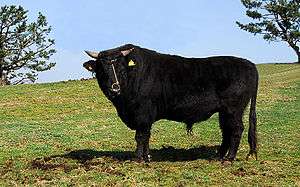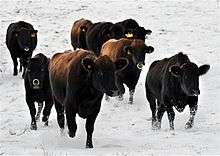Jeju Black
Jeju Black Cattle are one of the indigenous cattle breeds found in the Korean peninsula (Republic of Korea). Since the prehistoric age, this breed has survived in the subtropical environment of Jeju Island (a special self-governed province of Republic of Korea). Evidences found in the ancient documents (the Annals of the Joseon Dynasty - the annual records of Joseon Dynasty, and the Tamna Sullyeokdo- the paintings depicting Jeju’s official affairs during the Joseon Dynasty) about existence of Jeju Black Cattle described that beef of this indigenous cattle was served to the king or used as ritual offerings.

Although a prehistoric existence, a substantial shrink in its population size in Jeju Island has categorized the breed as endangered until 1980s. In the last few decades, South Korean government policies in agricultural industry focused on automation and increased agriproduct outputs which had also driven most industrial interest to breeding of the major local beef source known as Hanwoo cattle (‘Korean Native Cattle’ or ‘Han-u’) than other indigenous breeds such as Jeju Black Cattle. For years, as a consequence, this indigenous breed has lost its economic importance to cattle farmers, presumably because of their impaired growth performances in absence of systematic breeding schemes.
In the early 1990s, however, Jeju Stockbreeding Promotion Institute (Jeju SPI) took initiatives for implementation of a full-fledged preservation and proliferation policy targeting Jeju Black Cattle. To date, a total of 150 Jeju Black Cattle are being reared under the care of Jeju SPI. In 2013, Korean government formally declared the cattle breed as a valuable but an endangered animal genetic resource in the country and sanctioned a Natural Monument No. 546, to emphasize its better conservation and proliferation. Besides that a total of 619 Jeju Black Cattle has already been registered in the Korean seedstock database system of the Korea Animal Improvement Association.
Breed characteristics
Body conformation
Jeju Black Cattle are humpless, relatively smaller in body size and body length, short and slender legged compared to other indigenous Korean cattle, and coated with black hair over their entire bodies. Their foreheads are broad; ears are upright, short and round. Dewlaps on their briskets are rarely found. Horns are found in various types, and some of them have two colors; black on outer sides and white on the inner sides, also similar to Mishima cattle in Japan. The average height at withers of mature bulls and cows at 36 months of age are 137 cm and 125 cm, respectively. Also, their average body lengths found are 154 cm and 140 cm, respectively. On average, the body weights of mature bulls and cows are about 600 kg and 380 kg, respectively.
Breeding
Sexual maturity (age at first heat) of heifer calves of Jeju Black Cattle is attained around 15 months of age. The duration of the estrus cycle is roughly 20 days without seasonal variation. Average gestation length is about 280 days. Currently, most of them are bred through artificial insemination or embryo transfer.
Climatic adaptability and disease resistance
They show superior vigor and endurance in the local climate. They show strong tolerance during winter season; however, they exhibit less tolerance in the heat of summer, mostly like many Bos taurus cattle breeds. They are also generally resistant to many common bovine diseases and parasites, i.e. ticks or mites, which especially favor their grazing under subtropical environments.
Meat characteristics
Jeju Black Cattle beef was once served to the king because of its excellent taste. It has an excellent texture and marbling. Loin muscles of these cattle are thin and have delicate deposits of fat particles, contributing to rich flavor and tenderness. Jeju Black Cattle beef is especially richer in oleic acid, linoleic acid, and unsaturated fatty acids than beef of Korean native cattle (Han-u). It is therefore appraised as a potential well-being food with excellent taste approved by gourmet panels.
History
The first historic painting of Jeju Black Cattle was found on a mural of an ancient tomb named Anak Tomb No. 3 during the Goguryeo Dynasty in 357 AD. There also exist ancient documents, the Annals of the Joseon Dynasty and several others that described the shapes of cattle breeds. History of breeding of Jeju Black Cattle in Jeju Island dated back to 1702 AD, during the 28th year reign of King Sookjong. The administrator of Jeju-mok regional office at that period, known as Yi Hyeong-sang, surveyed around whole island, and those records were collected in Tamna Sullyeokdo. According to his report, a total of 703 black cattle were raised at that time in the island. Also, recent scientific evidence (based on DNA analysis of bones recovered from Gonae-ri and Gwakji-ri in Aewaleup, Jeju City) was provided by a professor in Jeju National University (Oh et al., 2005) that ancestors of the present Jeju Black Cattle had been raised by humans since prehistory.
However, Jeju Black Cattle became endangered especially during the Japanese colonial period in 1920s. Most of the Jeju Black Cattles were forcefully dispossessed and shipped to Japan. Since 1992, scientists in Jeju Stockbreeding Promotion Institute have collected Jeju Black Cattle which were scattered at private farms in Jeju Island and managed as a group of genetic resource. They are also carrying out preservation/proliferation projects. As per their project goals expectations, if successful, over 600 of these black cattle will exist in Jeju area in near future. Jeju SPI also developed a breed discrimination tool using genetic markers. This tool has been applied to retain the uniqueness of the Jeju Black Cattle breed. In 2013, Republic of Korean government acknowledged the historical and cultural values of Jeju Black Cattle and assigned it Natural Monument No. 546 of National Cultural Property to prevent extinction and preserve the breed. The Korea Animal Improvement Association, which mainly functions for management of individual identification and pedigree information of seedstock animal owned either by institutions or private breeders, also manages breeding herd information of Jeju Black Cattle in their registration database system, which is open to public.

References
- Kim, Hwan-kyeong (1964). “A Study on the Distribution of Coat Colors of Jeju’s Native Cattle”. The 2nd Collection of Treaties, Dong-A University.
- Park, Yeong-il (1971). “A Study on the Frequency of Coat Colors of Jeju’s Native Cattle”. Vol.13, Korea Stockbreeding Academy.
- Park, Yeong-il (1972). “Relationships between the Coat Colors and the Measured Body Lengths of Jeju’s Native Cattle”. Vol. 14, Korea Stockbreeding Academy.
- Yang, Yeong-hoon (2000). The Measurement System of Han-u and Measurement Condition of Jeju Black Cattle: Research Institute for Animal Science, Jeju National University.
- Kim, Kyu-il (2003). Phylogenic Relationships of Northeast Asian Cattle to Other Cattle Populations Determined Using Mitochondrial DNA D-Loop Sequence Polymorphism: Springer. Vol. 41(3) Numbers 3-491-980006-2928 SCIE.
- Kim, Jae-hwan (2005). Molecular Genetic Analysis of Ancient Cattle Bones Excavated from Archaeological Sites in Jeju, Korea: Korea Society for Molecular and Cellular Biology. Vol. 20(3) 1016-8478 KCI.
- Yoon, Doo-hak (2007). Allele Frequency of the Bovine Y-chromosomal Microsatellite Locus in the Cattle Breeds: Korean Society for Animal Science and Technology. Vol. 49(4) 1598-9429 KCI.
- Choi, Tae-jeong (2009). Establishment of Phylogenomic Characteristics for Korean Traditional Cattle Breeds (Hanwoo, Korean Brindle and Black): Jeonbuk National University.
- Yi, Seong-soo (2009). Relation of Expression Levels of Melanin Synthesis Genes According to the MC1R Genotypes with the Coat Color Patterns in Hanwoo, Jeju Black Cattle and Holstein: Korean Society of Life Science. Vol. 19(3).
- Han, Sang-hyeon (2010). Verification of ET and AI Derived Offspring Using on the Genetic Polymorphisms of Microsatellite and Coat Color Related Genes in Jeju Black Cattle: Korean Society of Life Science. Vol. 20(3).
- Han, Sang-hyeon (2011). Coat Color Patterns and Genotypes of Extension and Agoutiin Hanwoo and Jeju Black Cattle: Korean Society of Life Science. Vol. 21(4).